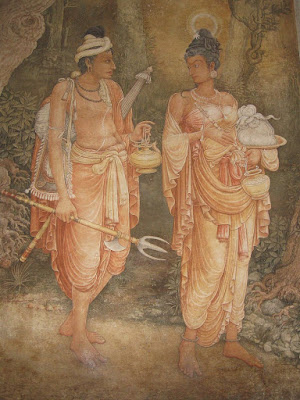Trade routes of Kalinga Sailors to Ceylon, Java, Sumatra and Bali
“The entire two-way trade
route of 14,000 kms from the mouth of Mahanadi to Bali and
back used to be completed by Kalinga Sadhabapuas in about 180 days (during
mid-November to mid-May). The ships used to sail at a speed of 4.86 k.p.h. The
seaworthy sailing period was 120 days while the rest 60 days were spent on
trading and rest.”
The Kalinga Sadhabapuas voyaged
to Bali in
the sea-worthy country boats and used to take advantage of the North East
monsoons, which normally starts from November. By taking advantages of this
retreating monsoon (North East Monsoon) the boats used to sail from Mahanadi
mouth down to the South West along the East Coast of India right up to
Nagappattinam in the Cauvery Delta and Point Calimere 10 degree 20’N latitude
further south, just north of Palk
Strait . The Kalinga sailors used to trade all
along their South West ward voyage along the East Coast of India and used to
replenish the essential provision like food and water, if required. Thus, the
sailors were not taking all the essential provisions right from the starting
point as the capacity of the sailing ships then were very much limited. From
Point Calimere they used to cross the Palk
Strait (10 deg. 0’ N latitude) by taking
advantage of the same North East Winter monsoon ( North East Trade Winds) which
become stronger as we move to low latitudes. The eddy current of East Coast of
India at Palk Strait also helped them to sail to the East Coast of Singhala (Sri
Lanka Sri
Lanka , before they entered the deep seas
of the Indian
Ocean . Till this point getting essential provision
like food( both dry and wet ) and water were posing no problems as they used to
be replenished all along the East Coast of India and Eastern and Southern
Coasts of Sri Lanka from each port of call before they entered the deep seas of
the Indian Ocean.
From Bali they used to
enter the Java Seas through Denapaser Strait which
separates the Bali Island and Lambak Islands and
used to trade in Celebs (Sulawesi ).
Thus, the entire voyage from the Mahanadi Mouth to Bali used
to take about more than 60 days i.e. from Mid-November to mid-January. The
trading time there must have been about two to three months in the South
East Asia .
Weather Conditions:
It is a well-known fact
that Kalinga sailors were well acquainted with the prevailing weather
conditions, wind directions and currents of the Bay of Bengal and Indian
Ocean . This becomes abundantly clear from an
analysis of the cyclones of the Bay
of Bengal during past 103 years (1877-1980),
for which data are available from the Indian Meteorological Department
(I.M.D.). In Orissa Coast Orissa Coast ,
when the Kalinga sailors used to set their sails from the Mahanadi mouth.
In about a month’s time they used to cross the Andhra Coast and Coromandal Coast to
reach Sri
Lanka Coast
The Kalinga sailors used
to leave Sri
Lanka Coast by
mid-December to sail in the mid-Indian Ocean to reach Bali Coast Coromandal Coast is
free of cyclones in mid-March and during mid-April to mid-May both Andhra Coast and Orissa Coast
This period is the calmest
season in the Bay of Bengal since only 9 cyclones have hit Orissa-West Bengal Coast
By March-end (23rd March)
the shifting of the pressure belt takes place as the sun remains vertically
over the Equator (Equinox i.e. March 21st) and the Equatorial Belt
of Calm assumes the normal position i.e.5 degree N 5 degree S latitudes. This
shifting of the Equatorial Belt of Calm must have helped the Kalinga sailors to
sail back through the Equatorial Belt of Calm westwards from Bali Coast to
reach the southern tip of Sri Lanka (Dondra Head) which is just to the north of
the Equatorial Belt of Calm the end of April when by the South West monsoons
start to gain momentum. The sailing ships return by the same route along the
east coast of India from
South West to North East by taking advantage of the South West monsoons and
offshore long current to reach the Mahanadi mouth by mid-May, i.e. before the
turbulent cyclones in the Bay
of Bengal start.
Conclusion
Thus, the
outward journey starts from Mahanadi mouth by mid-November and reach Bali by
mid-January, a journey of two months in the sea. They trade in South East Asian
countries for two months (mid-January to mid-March). Significantly this period
is comparatively free from very heavy equatorial showers which provides an
ideal climate for trading in this equatorial region. They start their return
journey by mid-March to reach Kalinga Coast
(Compiled from the
book “Kalinga-Indonesia Cultural Relations” published by OIMSEAS, Bhubaneswar)




An insightful note on the sea voyages of Odishan sailors and their trade route.But it seems to be too much Mahandi mouth-Bali centric.The entire sea coast of Odisha from Balasore and Midnapore in the north to Ganjam and Godavari delta in the south, which were parts of Odisha till 16th century may be credited with taking an important role in the sea faring activities of Odisha from where ships sailed to South East Asian countries, Ceylon, Coromandel coast and Maldive Islands when north east monsoon started to blow.Perhaps it will be more appropriate to say' Mahanadi delta' than ' Mahanadi mouth' as the mouths of river Debi, Prachi, Kushavadra, Chitrotpala and Bhargavi played more important role role in maritime activities than Kujanga, the actual mouth of Mahanadi.Similarly, as per documentation is concerned they are replete with information about Odisha's trade link with Sumatra, Java, Bantam, Malay and Siam than Bali Islands.So the link with Bali perhaps may not be over-emphasized.
ReplyDelete